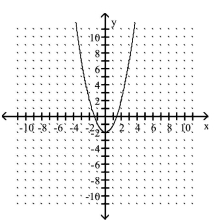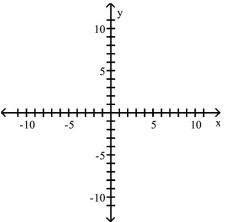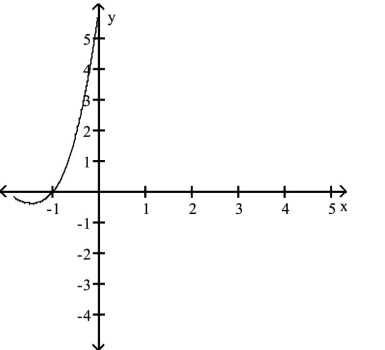A) 3
B)
C) 0
D) 9
F) B) and C)
Correct Answer

verified
Correct Answer
verified
Multiple Choice
Find the zeros of the polynomial function. -
A)
B)
C)
D)
F) A) and C)
Correct Answer

verified
Correct Answer
verified
Multiple Choice
Write an equation that expresses the relationship. Use k as the constant of variation. -If the force acting on an object stays the same, then the acceleration of the object is inversely proportional to its mass. If an object with a mass of 15 kilograms accelerates at a rate of 2 meters per second per second by a force, find the rate of acceleration of an object with a mass of 3 kilograms that is pulled by the same force.
A) 10 meters per second per second
B) meters per second per second
C) 8 meters per second per second
D) 5 meters per second per second
F) A) and B)
Correct Answer

verified
Correct Answer
verified
Multiple Choice
Divide using long division. -
A)
B)
C)
D)
F) All of the above
Correct Answer

verified
Correct Answer
verified
Multiple Choice
The graph of a quadratic function is given. Determine the function's equation.
-
A)
B)
C)
D)
F) None of the above
Correct Answer

verified
Correct Answer
verified
Multiple Choice
Find the zeros for the polynomial function and give the multiplicity for each zero. State whether the graph crosses the x-axis or touches the x-axis and turns around, at each zero. -
A) , multiplicity 1 , crosses -axis; 5 , multiplicity 3 , crosses -axis
B) 3, multiplicity 1 , crosses -axis; , multiplicity 3 , crosses -axis
C) -3, multiplicity 1 , crosses -axis; 5 , multiplicity 3 , touches -axis and turns around
D) 3 , multiplicity 1 , touches -axis; , multiplicity 3 , touches -axis and turns around
F) A) and B)
Correct Answer

verified
Correct Answer
verified
Multiple Choice
Find the indicated intercept(s) of the graph of the function. - -intercepts of
A) and
B) and
C) and
D) none
F) A) and D)
Correct Answer

verified
Correct Answer
verified
Multiple Choice
Use transformations of f(x) to graph the rational function.
-

A) ![]()
B) ![]()
C) ![]()
D) ![]()
F) B) and C)
Correct Answer

verified
Correct Answer
verified
Multiple Choice
Find the x-intercepts (if any) for the graph of the quadratic function. -
A) and
B) and
C) and
D) and
F) None of the above
Correct Answer

verified
Correct Answer
verified
Multiple Choice
Use the graph or table to determine a solution of the equation. Use synthetic division to verify that this number is a
solution of the equation. Then solve the polynomial equation.
-

A) ; The remainder is zero; , and , or
B) ; The remainder is zero; , and , or
C) ; The remainder is zero; , and , or
D) ; The remainder is zero; , and 3 , or
F) B) and D)
Correct Answer

verified
Correct Answer
verified
Multiple Choice
Find the zeros for the polynomial function and give the multiplicity for each zero. State whether the graph crosses the x-axis or touches the x-axis and turns around, at each zero. -Crosses the -axis at , and 4 ; lies below the -axis between and 0 ; lies above the -axis between 0 and
A)
B)
C)
D)
F) B) and C)
Correct Answer

verified
Correct Answer
verified
Multiple Choice
Determine the constant of variation for the stated condition. - varies directly as and when . Find when .
A) 195
B) 169
C) 225
D) 144
F) All of the above
Correct Answer

verified
Correct Answer
verified
Multiple Choice
Solve the rational inequality and graph the solution set on a real number line. Express the solution set in interval
notation.
-
![Solve the rational inequality and graph the solution set on a real number line. Express the solution set in interval notation. - \frac { x } { x + 3 } > 0 A) ( - \infty , - 3 ) or ( 0 , \infty ) B) ( - 3,0 ] C) ( - \infty , - 3 ] or [ 0 , \infty ) D) ( 0 , \infty )](https://d2lvgg3v3hfg70.cloudfront.net/TB7044/11ecb8a6_f881_066d_9b96_25303fcf5ee8_TB7044_00.jpg)
A) or ![]()
B) ![]()
C) or ![]()
D) ![]()
F) A) and C)
Correct Answer

verified
Correct Answer
verified
Multiple Choice
Determine whether the function is a polynomial function. -
A) Yes
B) No
D) undefined
Correct Answer

verified
Correct Answer
verified
Multiple Choice
Find the x-intercepts (if any) for the graph of the quadratic function. -
A) and
B) and
C) and
D) and
F) C) and D)
Correct Answer

verified
Correct Answer
verified
Multiple Choice
Determine the maximum possible number of turning points for the graph of the function. -
A) 2
B) 5
C) 3
D) 0
F) All of the above
Correct Answer

verified
Correct Answer
verified
Multiple Choice
Solve the problem. -The revenue achieved by selling x graphing calculators is figured to be x(42 - 0.5x) dollars. The cost of each calculator is $22. How many graphing calculators must be sold to make a profit (revenue - cost) of at least $182.00?
A) between 14 and 26 calculators
B) between 19 and 31 calculators
C) between 15 and 25 calculators
D) between 16 and 24 calculators
F) A) and B)
Correct Answer

verified
Correct Answer
verified
Multiple Choice
Write an equation that expresses the relationship. Use k as the constant of variation. -a varies inversely as the square of .
A)
B)
C)
D) If y varies inversely as x, find the inverse variation equation for the situation.
F) A) and B)
Correct Answer

verified
Correct Answer
verified
Multiple Choice
Determine the constant of variation for the stated condition. -If varies directly as the cube of , and when , find when .
A) 320
B) 20
C)
D)
F) A) and B)
Correct Answer

verified
Correct Answer
verified
Multiple Choice
Divide using synthetic division. -
A)
B)
C)
D)
F) A) and D)
Correct Answer

verified
Correct Answer
verified
Showing 301 - 320 of 532
Related Exams